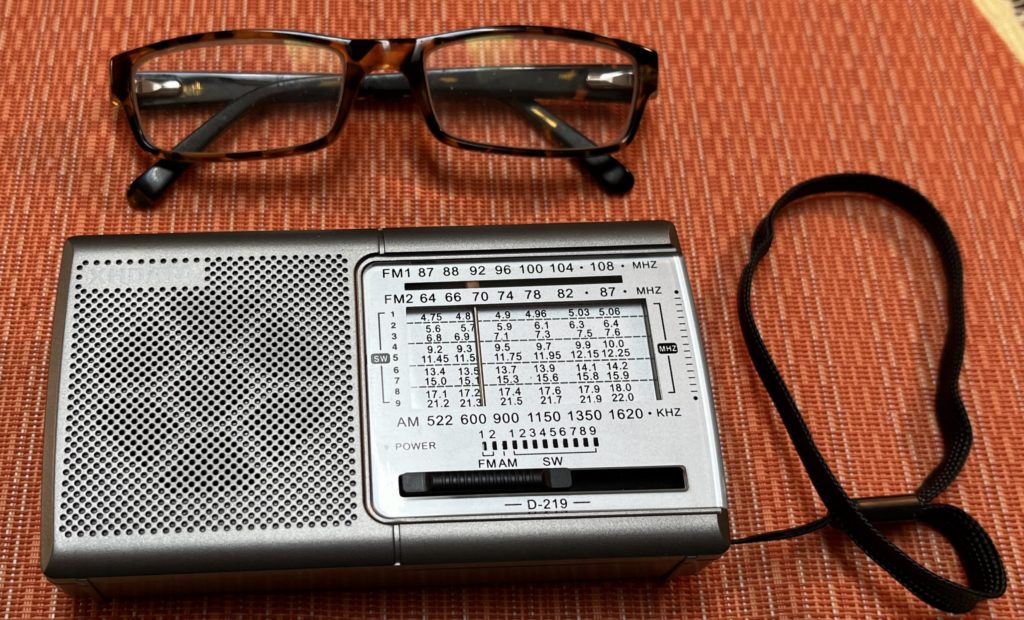The XHDATA D-219 is an AM/FM/Shortwave radio with an analog tuning dial. It covers AM (only up to 1600 kHz), FM (2 bands) and shortwave (9 bands from 4.75 to 22 MHz) It doesn’t have much in the way of features, but it gets the job done and is the best performer I’ve encountered in the under-$20 price bracket. It’s particularly attractive at today’s $12.99 including shipping from Amazon, or at $11.38 on sale direct from XHDATA where I got mine. (Note: the one shown below is the international version, identifiable by the 522-1620 MW scale. From Amazon you will get the US version 520 – 1710 with 10 kHz step.)

It has a generous 20.5″ telescoping antenna, an earphone jack, wrist strap and a kickstand. It lacks a dial light and FM Stereo. It takes 2 AA batteries and can be powered by a 5V external DC p0wer source. It comes with a basic manual that no one should need.
One issue for potential buyers in North and South America is the MW (AM) channel spacing, set permanently at 9 kHz, while the stations in this region broadcast on frequencies that are a multiple of 10 kHz. The radio itself has a digital signal processing (DSP) chip that only tunes discrete channels, even though you can physically set the dial to anything. The upshot of this disparity is that you wouldn’t be able to tune weak stations next to strong ones when the multiples don’t line up, and that you will hear the same station on two adjacent locations on the dial when the station frequency lies between the radio’s channels. This is really only an issue when you’re trying to trying to receive distant stations, and not likely to be an issue just listening to local AM. It’s fine for the rest of the world.
I ran a comparison of the D-219 against several other sub-$25 units on AM and FM. It was among the top contenders. I also scanned the shortwave bands using just the internal whip antenna. I was able to receive a couple dozen stations in the daytime. I could reliably set the dial to 15 MHz and from central Virginia receive WWV in Ft. Collins, Colorado. There are gaps between the shortwave bands, excluding much non-broadcast parts of the spectrum; however, it covers international broadcasting. In the US, you should easily receive stations like China National Radio and Radio Romania.
Shortwave bands:
- 4.75 – 5.06 MHz
- 5.6 – 6.4 MHz
- 6.8 – 7.6 MHz
- 9.2 – 10.0 MHz
- 11.45 – 12-25 MHz
- 13.4 – 14.2 MHz
- 15.0 – 15.0 MHz
- 17.1 – 18.0 MHz
- 21.2 – 22.0 MHz
Here are some test results scanning MW and FM bands using radios outdoors using the built-in antennas. I live in a weak signal area for MW.
Note: the table below shows the more recent 10 kHz MW step model of the D-219.
This is definitely not a radio for the serious shortwave listener or for the audiophile, but for a radio to carry with you camping or to dabble in shortwave, you can’t go wrong at this price.

Today these were less than $8 from Amazon. I have one, and 1. For the price it’s really nice 2. It’s just really nice, period.
Spend $40-50 more and you can get quite a bit more from XHData. But the D-219 is actually a good radio, regardless of price.
Thanks for the review. I occasionally see a report on this one and it certainly seems usable. Here at the end of July 2024 Amazon has it for $9.76 and an additional 10% off coupon for the gray model. Yes, that’s $8.78! Add sales tax and deduct a small Prime reward that I had available and I got it for $8.00. 🙂 Some reports suggest that the gray is 10 kHz and the silver is 9 kHz tuning on MW. I guess I’ll find out tomorrow. (Yep, free one day shipping, too.)
You can’t tell the 9 kHz from the 10 kHz model by the color, but by the labeling on the front. The photo that heads this article is the 9 kHz model, which is distinguished by the MW band going from 522 to 1620 kHz. The 10K model goes from 520 to 1710 kHz. If you got on Amazon US, then it’s almost certainly the 10kHz model.
I bought a D-219 in May 2024 that is a 10K (MW) USA model. Very impressed!